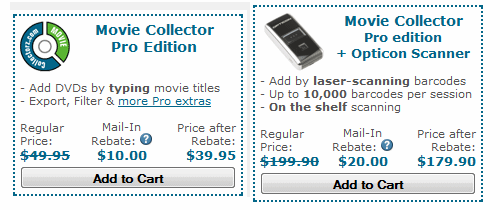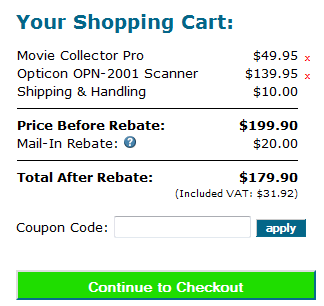 At SIC 2009, Sytske and I talked with the RebateDelivery people, Jason Foodman and Steven Miller.
At SIC 2009, Sytske and I talked with the RebateDelivery people, Jason Foodman and Steven Miller.
We have worked with these guys for years, when they were running SwiftCD, so we were curious to hear what they were up to now.
Well, in short, RebateDelivery is a new system for offering Mail-In Rebates for online software purchases. Let’s look at the details of how it works and how to use it to improve sales. Oh, and of course I am running a new A/B split test to find out if it indeed helps to sell more software 🙂
What is RebateDelivery?
Well, here’s a quote from their FAQ:
RebateDelivery is a patent-pending service enabling software, game, and e-commerce firms to offer real mail-in rebates to consumers purchasing software and games online.
In case you’re not familiar with the concept of a mail-in rebate: A Mail-In Rebate gives the customer part of their money back, after the purchase. They pay the regular price for the product first. Then after the purchase, they can send in a card or form by regular mail to get the rebate amount back, either by check or bank transfer.
Of course, the idea is to increase conversion rates, to get more people to buy. If in the end the extra profits outweigh the amount of paid out rebates, we make more money. According to the RebateDelivery FAQ, less than 40% of customers actually claim their rebate, which increases the chances of increasing profit margins.
Mail-In Rebates are heavily used in retail, especially in the US, but not online. The RebateDelivery system now lets vendors offer rebates to their customers for online purchases. Here’s how that works:
After their purchase, customers receive a link to the GetMyRebate website. On that website they can print a form, fill it out and mail it in to an address near them. RebateDelivery then handles the pay-out of the rebate amount.
Plus, RebateDelivery has added to the mail-in rebate concept by allowing vendors to provide several “alternative offers”. With these alternative offers in place, people coming to the GetMyRebate website are offered one or more alternative ways to claim their rebate, e.g. by opting for a free software product (usually having a value higher than the rebate amount). This helps to further reduce the percentage of rebates that are actually paid out.
How to use Mail-In Rebates for software sales?
Having listened to Jason and Steven explain the system, it took me a while to really understand how I would be able to apply this to my business. I mean, is this an alternative or replacement for using discount coupons? What’s the difference exactly? Or should this be used in a completely different way?
Rebates vs Discount Coupons
First, some “technical” differences:
Of course, the obvious difference is that when using a coupon, the discount is immediate, that is, the customer only pays the discounted amount. Whereas with a rebate he pays full price and *can* get the rebate amount back later.
Another important difference is that with coupons you can give a specific discount to specific parts of your audience. For example, at Collectorz.com we give $5 coupons to everyone who signs up for the free trial, and $10 coupons to existing customers. Also the coupon system is built into your regular checkout process: Everyone who has a coupon enters it into the special box and gets the discount. Everyone who doesn’t have one pays full price.
With a rebate this is more difficult. There is no built-in way to give the rebate to specific customers. You just sent out the “get my rebate” link to everyone who completes a transaction. The only way to give the rebate to specific customers would be to create specific check-out pages.
Rebates are for all customers, especially *new* customers
The above two differences mean that rebates should be used in a way that is completely different from how you would normally use discount coupons.
First, if you have one shopping cart / check-out page, the rebate is given to everyone who buys. So rebates are more suited to do promotions to all your customers, as a way to increase your overall conversion rate. Then, the fact that is not an immediate discount means that is less suitable for special offers to specific customers anyway, especially if they are existing, loyal customers. IMO, it’s not a good idea to make your loyal users jump through the hoops of printing a form and sending it in by regular mail, just to make use of your special offer.
So rebates should be given to all customers, especially new customers who are buying their first product from you. And if we are going to give the rebate to everyone, we might as well make sure everyone knows about it, and as early as possible, preferably on the landing page. This way we can maximize the positive effects on the conversion rate.
Technical Implementation
What does it take to implement RebateDelivery for your site and shopping cart? Basically, there’s five parts to that:
- Setting up your rebates and alternative offers: Use the RebateDelivery vendor system to define your rebates and your alternative offers, including descriptions, amounts, etc…
- Displaying the rebate: You won’t get a positive effect on conversions if your visitors don’t know about the rebate. So you should display the rebate on your website and during checkout.
- Notifiying RebateDelivery of orders: The RebateDelivery system has to know about all orders that are processed successfully, so that they can handle the claiming of rebates. You can notify them using a SOAP interface or a simple HTTP POST.
- Giving your customers the GetMyRebate link: You can give them their personal link (including a unique transaction id) on your “thank you” page or in their order confirmation email (or both).
- Handling alternative offers: When a user opts for one of your alternative offers, you have to make sure they actually get it. RebateDelivery can notify you by email or using an HTTP POST (or both).
Testing RebateDelivery on Collectorz.com
Giving rebates to everyone sounds scary, doesn’t it? Ok sure, not every customer will claim their rebate, but a lot of them will, costing you money. Will your conversion rate increase enough to pay for those rebates and, preferably, result in some extra profits?
Well, there’s only one way to find out… just test it and track the results. So that’s what I am doing at the moment. I am currently running an A/B split test, where all B-visitors get the rebates and all A-visitors don’t.
For that B-group, I have defined three different rebates:
- A $10 rebate for everyone who buys a Pro edition of our software.
- A $15 rebate for customers buying a Pro edition plus a CueCat barcode scanner.
- A $20 rebate for people who opt for Pro software with the expensive Opticon barcode scanner.
The rebates are displayed prominently on my landing pages, in the “buying choices” panel on the right, like so:

During check-out, the shopping cart uses similar “Price after Rebate” terminology:

In both places I added a little question mark thingie, that when clicked shows the following explanation in a pop-up window:
What is a Mail-In Rebate?
A Mail-In Rebate gives you part of your money back, after the purchase.You pay full price for the products you buy, but as soon as you have completed your purchase, you will receive a link to our “Get My Rebate” website.
On this website, you can print your personal rebate form. Return that form by regular mail to receive the rebate amount back, either by check or bank transfer.
Currently I am not allowing coupons to be used in combination with a rebate. When a customer uses a discount coupon, the rebate automatically disappears. I am not sure if that is the best way to do it. Maybe I should do a further split test later, to find out.
Generally speaking, I expect that it will take some experimentation to optimize results, maybe even to just get it to work at all. I saw the same when I started using TrialPay and also with McAfeeSecure. This is not something you can just implement and be done. It’ll take time to find the best ways to use it, to optimize the rebate amounts, the alternative offers, the presentation on your website, etc…
Coming soon: the results of the A/B split test
I started my RebateDelivery A/B split test on September 4, so it has been running for 10 days now.
I am planning to let it run for at least 14 days, maybe longer. The full results of this test will be posted here later. For now, I can tell you that preliminary results are promising 🙂

How do you manage the taxes in Magento? I mean how do you apply the discounts.. Any tips?